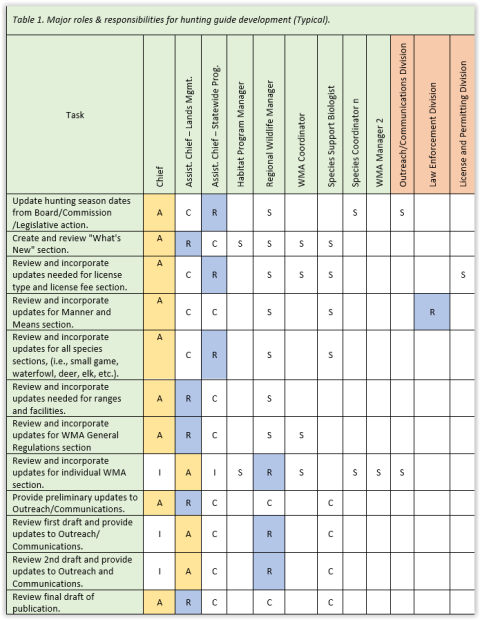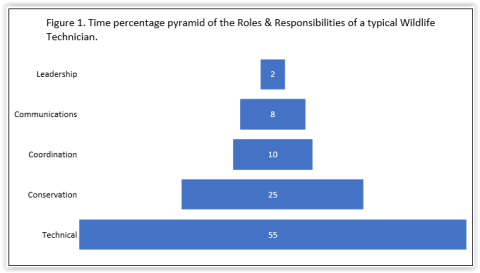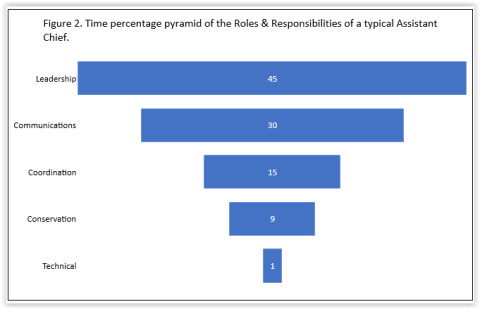Breadcrumb
- Home
- Outdoor News Bulletin
- June 2021
- Whose Job Is It Anyway? The Roles and Responsibilities of Fish and Wildlife Agency Staff
Outdoor News Bulletin
Whose Job is It Anyway? The Roles and Responsibilities of Fish and Wildlife Agency Staff
Ask any of your employees about their current workload, and you will likely hear “I’ve got more on my plate than I can handle…” or “What am I currently doing that you want me to stop so that I can take on this new assignment?” We have all been there. It’s human nature for people to adopt a task for which they have an interest or passion, even if it’s not in their area of responsibility. And while the use of a strategic plan to set organizational goals and re-imagining an organizational structure to optimize supervisor to staff ratios can all contribute to increased efficiency and ultimately to long-term organizational success, these types of forward-thinking actions will undoubtedly founder if staff aren’t working within their area of responsibility. To ensure staff are working on the right tasks and with the right amount of effort, the Wildlife Management Institute often assists our partners in conducting a Core Function Analysis (CFA) of the positions and functions within their organization.

A CFA performed for all positions and major functions in an organization is useful in ensuring that everyone is working on the tasks for which they are responsible as well as working at the appropriate level of responsibility. It also identifies areas where staff may be committing resources to tasks that are not part of their job. Decades of agency reviews have convinced WMI that many of the functions (both major and minor) of an agency often involve many more staff than necessary—in essence, there are “too many cooks in the kitchen.” Using a CFA to develop and refine both positional and functional roles and responsibilities (R&R) creates clarity, efficiency, accountability, and transparency for the organization. This is especially critical for government agencies, who are often constrained by generic position descriptions developed by a larger personnel entity with an eye toward “one size fits all.”
Many government agencies use personnel classifications to describe their positions. These are often intentionally broad to keep the number of overall classifications to a manageable level. For example, the classification title “Wildlife Manager 2” could describe any number of positions, including such diverse positions as Public Lands Managers, Private Lands Biologists, Wildlife Habitat Biologists, Wildlife Health Specialists, and Foresters. Additionally, multiple divisions within an agency may use many of the same classifications (e.g., a classification such as Fisheries & Wildlife Manager). Staff that share a common classification often have very different job duties. A necessary first step in conducting a CFA is deciding on a consistent set of working titles for positions in order to minimize the ambiguities associated with using position classification titles. Overall, the development and use of clear and distinctive working titles helps to foster a better understanding of the specific roles assigned to a position and/or function.
Roles & Responsibilities – Who’s on First
Taken as a whole, the duties of a position, team, or larger work unit serve to define the core function of that entity. The information derived from a CFA defines what, how much, and to what degree the employee, group, or entity being examined is supposed to be involved. WMI almost universally hears from staff who want to be involved “in everything” and yet complain of complicated processes, too many people involved, too many meetings, and cumbersome decision-making processes. The product of a CFA importantly informs an employee, group, or entity what they are responsible for, but perhaps more importantly, what they are not responsible for.
While there is often some initial anxiety by staff resulting from explicitly describing their work responsibilities to this level of specificity, it should be considered a necessary re-alignment to ensure proper and efficient organizational function. R&R take on two forms: Functional and Positional. Functional R&R describe the larger, more complex critical needs that an organization requires by breaking the function down into component tasks and making assignments of those tasks to a number of employees across an organization. Functional R&R almost always span many positions and often multiple units, sections, or other administrative divisions. Conversely, Positional R&R are the distilled essence of the core tasks that are often the sole responsibility of the employee filling a particular position.
Functional Roles & Responsibilities
To evaluate the Functional R&R of an organization, WMI has adopted a practice common to the business world, but seldom used by government agencies. This technique uses a RASCI model to describe the R&R for actions associated with major functions. The acronym RASCI stands for Responsible, Accountable, Supportive, Consulted, and Informed. The practice is used to identify staff responsible for each individual task associated with a major function by giving each relevant position the appropriate assignment (who is involved) and correct level of responsibility.
RASCI is a well-established management technique used by all sizes of businesses. It is an easy way to allow managers to delineate staff R&R for any initiative or function. RASCI has also been described as a “Responsibility Assignment Matrix,” in that it describes people’s participation (i.e., various roles) in completing tasks or deliverables for a project, program, or process.
When used properly, a RASCI model communicates R&R on key functions and also confers numerous benefits, including:
- Increasing the speed with which decisions can be made so work can be accomplished.
- Giving teams an ‘at a glance’ confirmation of who is doing what.
- Making managing a team’s work more efficient.
- Ensuring tasks have the right roles assigned and illuminating inconsistencies between tasks.
- Allowing all team members to know who owns each piece of the project.
- Avoiding the blame game, as everyone is clear on their responsibility level.
- Balancing workloads by making overloaded team members more apparent.
- Eliminating duplication of effort and not having “too many cooks in the kitchen.”
- Accommodating onboarding and team member changes.
A RASCI analysis describes each person’s functional role in delivering projects or programs as follows:
Responsible – “I get it done.” This is the person or group responsible for managing the work of others or performing the task or function. Only one staff member is identified as being responsible for a given task. This avoids confusion and duplicated effort.
Accountable – “The buck stops here.” This is the person who is held accountable for the task or function being completed. Ideally, only one person should be accountable. It’s important to note that the same person cannot be both an R and an A. If they are, it would result in a consolidation of duties issue where there are insufficient checks and balances.
Supportive – “I execute the work.” This is the person who does the work of the task. In some cases, the R and the S may be the same person.
Consulted – “I should be part of the discussion.” These are stakeholders or staff who are consulted prior to a task being performed or completed. These people are typically subject matter experts who must be consulted prior to a final decision or action. This role is often part of a two-way communication, so care should be taken to limit the total number of C’s as it can add significant time to your project process.
Informed – “I want to know about it.” These are the stakeholders or staff who are informed about decisions and outcomes after a task is completed or a decision has been made. These people typically do not have input in a decision or action, and this is mostly one-way communication.
Minimally, any RASCI analysis describes the Responsible and Accountable parties for at least one task. However, most functions are made up of many tasks, and there often will be a great many staff involved, depending on the issue. Some important points are:
- There should be only one R per activity, and the R can simultaneously be an S, but never an A.
- Generally, the A party should be higher up the chain of command than the R party (this rule does not apply if the two parties are in separate supervisory chains).
- The A should be an individual who is both relevant and accessible to the project.
- There is only one A per activity and ultimate responsibility for getting the task or function accomplished accompanies A status.
- It is not necessary to have an S, C, and I for every task. However, if there are numerous gaps, it could be a sign that some stakeholders were missed.
- The number of people assigned to C and I should be kept to a minimum.

Agencies should consider developing RASCI matrices for each major function. Examples of these (for a Wildlife Division) may include:
- Season-setting
- Hunting guide development
- Harvest monitoring
- Population surveys
- Species management plans
- Disease monitoring and response
- Wildlife conflict management
- Wildlife research
- Prescribed fire operations
- Private lands technical guidance
- Wildlife habitat management
- WMA operations and maintenance
For each of these major functions, WMI assists in developing a list of the high-level tasks associated with that function, identifying the main staff/stakeholders, assigning the R and A for each task (and for the function where appropriate), assigning the S, C, and I categories, and reviewing the final products. Table 1 demonstrates the process for a function common to all wildlife agencies (hunting guide development). The Accountable persons are identified in orange, and the Responsible persons are identified in blue. All involved positions are identified, including positions or entities that may be outside the work unit (shaded in red in the example).
This resulting matrix provides a simplistic but comprehensive view of who should be doing the work and what their level of responsibility should be. It also creates an environment where staff are clear as to who conducts the tasks associated with that function—as well as who should not have involvement. The use of the RASCI matrix is still new to the conservation world, but it has the potential to be a game-changer when resolving the most common employee complaints involving workload and priorities.
RASCI matrices are simple tools to manage Functional R&R; however, they are not a silver bullet. In some cases, the function, or the associated tasks, or both may be complex or unclear. In these cases, a thorough evaluation of the function itself should be undertaken in order to understand those complexities so that they can be broken into their component parts. Functions and their associated tasks also tend to change over time. RASCIs are designed to be living documents and should be updated regularly as the tasks are modified, eliminated, or completed. Finally, while RASCI matrices provide a comprehensive visual representation of how and by whom a function should be accomplished, they do not address the unexpected tasks that often arise. RASCI matrices have great potential, but they must also be coupled with strong project leadership in order to be most effective.
Positional Roles & Responsibilities
A Positional R&R document is just that—one that explicitly describes the tasks associated with a specific position, rather than relying on generalized, irrelevant, and/or overly broad tasks described in a typical position classification document. Agencies should consider the development of Positional R&R for each discrete position within their organization. There are a number of ways to develop Positional R&R. WMI’s methodology uses the following five categories under which the essential functions and tasks of both professional and technical staff should fall:
- Leadership - guiding a team or individuals to achieve certain goals through direction and motivation. Encouraging others to take the actions they need to succeed.
- Communication - imparting or exchanging information. Successfully conveying or sharing information and knowledge.
- Coordination - organizing the different elements of an activity so as to enable them to work together effectively.
- Conservation - the preservation or responsible use of natural resources. Planned management of a resource to enhance or prevent exploitation, destruction, or neglect.
- Technical - using equipment, supplies, and knowledge to perform practical or applied work.

In practice, the starting point for developing Positional R&R is typically the current position classification. From that document, tasks that are unique to a particular position are assigned to one of the five categories. Staff input is then solicited to “fill in the gaps” of what a particular position does that sets it apart from other positions within the same classification. Staff input is reviewed by supervisors and senior level staff for accuracy and to ensure that the function is appropriate for the particular position. After supervisory review, any newly identified functions or tasks are categorized into one of the five categories and added to the Positional R&R document for that position.
Once the responsibilities for each position are described and categorized, they allow the user to quickly get a feel for an appropriate and accurate time allocation of a given position. This visual representation of where time should be spent for a given position is important to ensure that an employee is working at a level and on tasks that are appropriate for the position—and not working above or below that level. Often, there are widely differing responsibilities that depend primarily on position in the chain of command. For example, the R&R for a Wildlife Technician shows a normal pyramid (Figure 1). Whereas the R&R for an Assistant Chief shows a strong inverted pyramid (Figure 2). In many cases, positions sharing the same classification will have substantially different responsibilities due to the specifics of their particular job.

A comprehensive evaluation of Positional R&R helps provide guidance to staff and supervisors to ensure that staff in those positions are doing the work for which they were hired. It also provides a quick reference to identify employees that may be classified incorrectly.
Conclusion
Organizations are constantly faced with doing more with less. As tasks and functions get added, removed, modified, or accomplished, supervisors are often faced with an ever-changing landscape of who is handling what. WMI believes that one way to improve efficiency of operation and clarity of purpose is to explicitly define both Positional and Functional R&R. This approach to explicitly defining the R&R of organizational positions and functions is still new to the conservation world, but it has the potential to be a game-changer by helping to resolve workload and priority concerns that employees and supervisors may have. Further, an R&R exercise, coupled with a well-developed strategic plan, provides an organization and its employees with a clear roadmap to success.
If your organization would like to talk further about the Roles & Responsibilities process, please contact Jon Gassett.



